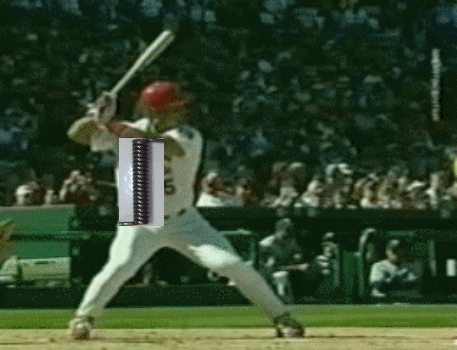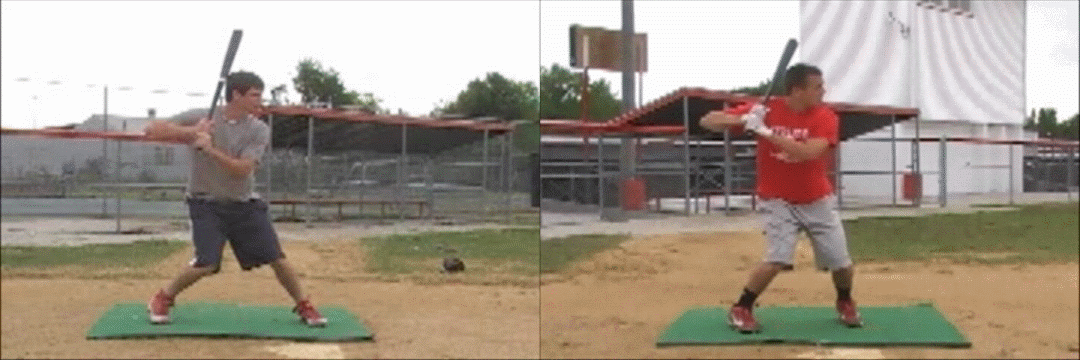A good load analogy is the bending of a sheet of sheet metal....almost to the point of it creasing....but not. When you bend it and release it you get a snap forward. That snap represents the SnF unload. That snap is what produces the suddenness of launch. When you pull back your hip/back/scap against the rear leg....until the range of motion is reached....and CONTINUE to pull back....you develop a 'bent piece of sheetmetal' load. Range of motion is gone, yet you're still pulling back. If you could you'd snap off the ball of your femur. The joint is tight. The stretch is very tight. When released you snap forward.
Now, the confusing thing is....most hitters are moving....and that movement is what you see. But that isn't the load. The load is 'underneath'. The movement you see provides a bit of momentum for the hitter. It IS NOT the load.
Another good example is how you load your forefinger against the thumb to flick a marble. Without the constant forward attempt by the forefinger, that is being held back by the thumb, you would not get the sudden explosion that you get when the thumb slides away. There is constant forward pressure (unload attempt) by the forefinger against the thumb....BUT THERE IS NO MOVEMENT.
A final analogy is the bow and arrow. Your hip, lower back, and scap are the string pulling rearward against your leg, the bow, that is trying to internally rotate. You develop a 'tug of war' like action in the rear hip socket. The hip, lower back and scap move at first....but then reach their range of motion limit. BUT THE PULLING BACK CONTINUES....IT MUST BE CONSTANT AND CONTINUOUS....and this activates the leg....it fights that pull back....it provides an equal and opposite response....it attempts to internally rotate even though there is little to no movement.
Now....all of this is about one thing....and that is to connect the scap to the rear leg. You fuse the upper body and arms into a unit by way of lower back and scap pull back. The hip coil pivots about the ball of the femur until it is tight and you end up with a torsion spring like stretch that runs from your leg to your scap.

When tight, the slightest movement in the leg is felt in the scap. And the slightest movement of the scap is felt in the leg. If you don't feel that....you aren't loaded.
If you are weak/loose in the hip socket, you have no stretch. If you are weak/loose at the scap/spine junction you have no stretch. Only when this torsion spring like stretch is created can your leg DRIVE your barrel. Without the torsion spring, your leg and hip will only provide momentum and your arms will have to take over and power the swing. Your leg moves, your hip moves....they provide momentum....but they don't DRIVE....until you have the torsion spring installed.
Here is a very good clip showing the difference....

On the left, disquised by all the preswing rhythm and movement you see, underneath, he creates the SnF load by getting a quality hip coil against his leg, and his lower back and scap constantly and continuously pull rearward to tighten the scap/spine junction. The torsion spring is installed. He is tight from his leg to his scap. This creates a 'feeling' that he is pivoting about that scap/spine junction. His hands turn the barrel to launch the swing. When that happens the SnF unload is very sudden. He whips around the corner.
On the right, the hitter fails to keep the scap/spine junction tight. He does not get a torsion spring installed. He does coil. He does pull back. But he loses it. The leg is never connected to the scap/spine junction. His leg and hip freewheel....they do not DRIVE....and he must power the swing with his arms....as evidenced by the scap pushing forward in and through contact. His lower body went into neutral....the drive train is turning....but the energy isn't reaching the barrel.

http://hittingillustrated.com/images...81312hands.gif
One's hands stay back as he turns the barrel. The other's hands are being driven forward by the arms.
One can whip. The other has to push.
Why?
One is back one is not.
One is pivoting about his scap/spine junction. The other is pivoting about his hip/leg.
It is counter-intuitive. You will struggle with it at first.
Hang in there. Make it happen.
Once you do it, you will never look at a swing again and not be able to tell what the hitter is doing....and how he is doing it.
You must unload INTO the load....not AWAY FROM the load.
Rearward, not forward.